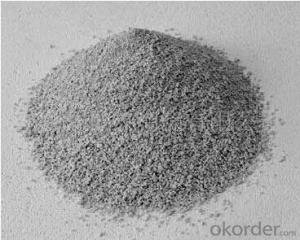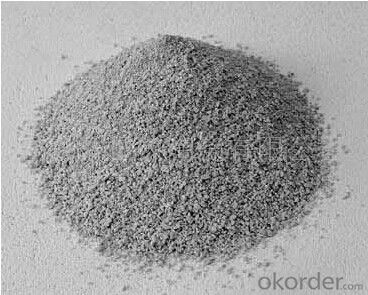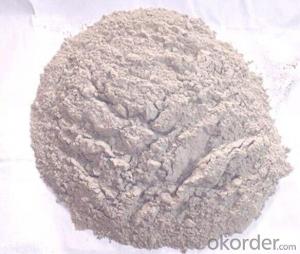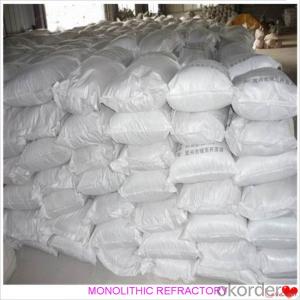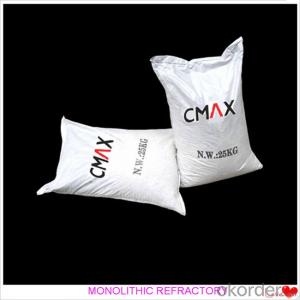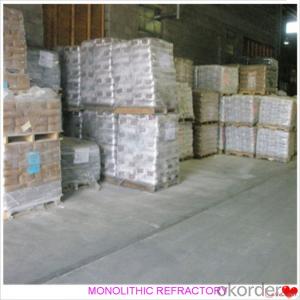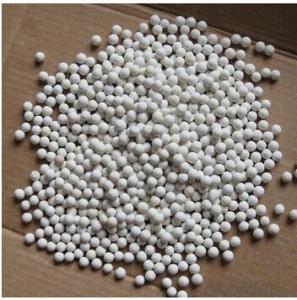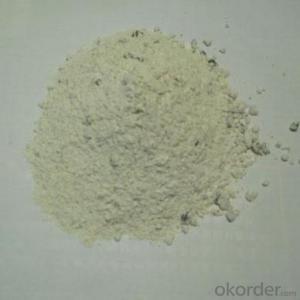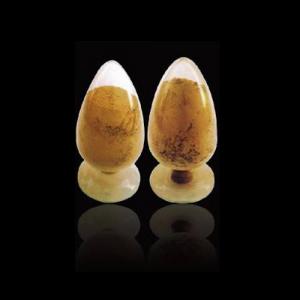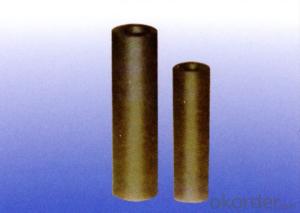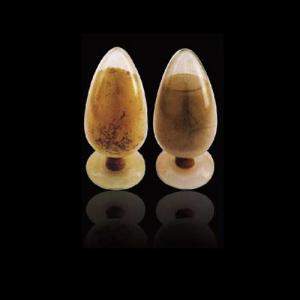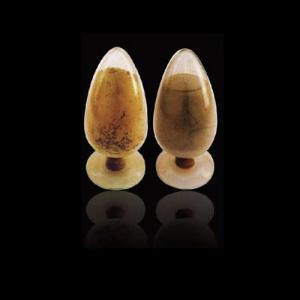Monolithic Refractories for Iron and Steel Industry:Mullite Heat Insulating Castable
- Loading Port:
- China Main Port
- Payment Terms:
- TT OR LC
- Min Order Qty:
- -
- Supply Capability:
- -
OKorder Service Pledge
OKorder Financial Service
You Might Also Like
characteristic:
construction convenient
using for furnace lining
wear-resistant,flame-proof
| Item | | insulating castable | ||||||
| JNL-45 | JBN-40 | JGL-85 | JGL-70 | JDL-80 | JLL-75 | JLL-60 | ||
| Al2O3 % | 45 | 40 | 80 | 70 | 80 | 75 | 60 | |
| CaO % | — | — | — | — | 2.5 | — | — | |
| Refractoriness °C | 1700 | 1670 | 1790 | 1750 | 1790 | 1790 | 1750 | |
| Linear change affter sintered ≤±1% | 1350°C ×3h | 1000°C ×3h | 1500°C ×3h | 1450°C ×3h | 1500 °C ×3h | 1500°C ×3h | 1450°C× 3h | |
| 110°C±5 After drying | Crushing strength Mpa | 8 | 20 | 35 | 30 | 40 | 30 | 25 |
| Modulus rupture Mpa | 1 | — | 5 | 5 | 6 | 5 | 4 | |
| Bonder | clay | water glass | cement | cement | lower cement | phosphate | phosphate | |
High-strength lightweight Insulating refractory castable
1. low bulk density, low thermal conductivity, high intension.
2. good integrity and excellent air impermeability.
3. be used as cover of warm or low- temperature heat engineering equipments
4. It can also be thensulating material in hot temperature furnace.
5. way of usagre: daubing or casting.
The index is as follows:
- Q: How are monolithic refractories applied in the hot face and cold face of furnace linings?
- Because of their superior thermal and mechanical properties, monolithic refractories are commonly utilized in furnace linings. These materials are employed in both the hot face and cold face of furnace linings, but their application methods differ for each. When it comes to the hot face of furnace linings, monolithic refractories are applied to endure extreme temperatures and harsh conditions. This area directly faces the heat source and is exposed to the highest temperatures. In this region, the refractory material is specifically engineered to possess excellent thermal conductivity and high resistance to thermal shock. To apply monolithic refractories in the hot face, the commonly used technique is gunning. Gunning involves the spraying or troweling of the refractory material onto the lining's surface. This technique enables quick and efficient application, ensuring a uniform and dense layer of refractory material. Gunning is especially suitable for areas with intricate shapes and contours. On the other hand, the primary concern for the cold face of furnace linings is insulation and protection. The cold face refers to the area that does not directly come into contact with the heat source and experiences lower temperatures. In this area, the refractory material is designed to possess low thermal conductivity and high insulation properties. The application of monolithic refractories in the cold face is typically accomplished using the technique called ramming. Ramming involves compacting the refractory material into place using a pneumatic or hydraulic ramming tool. This technique ensures the creation of a dense and solid layer of refractory material, providing excellent insulation and protection against heat loss. In conclusion, monolithic refractories are vital components of furnace linings as they provide the necessary thermal insulation and mechanical strength required in high-temperature environments. The application techniques of gunning and ramming allow for efficient and effective installation in both the hot face and cold face of furnace linings.
- Q: How are monolithic refractories inspected and tested for quality assurance?
- To ensure the reliability and performance of monolithic refractories, a series of rigorous processes are conducted for quality assurance. These inspections and tests play a crucial role in maintaining consistent quality standards and identifying any potential defects or weaknesses in the refractory material. The first step involves conducting visual inspections to check for visible defects such as cracks, spalling, or signs of poor manufacturing. This helps in identifying any obvious issues that may affect the refractory's performance. Following that, specialized equipment is used to measure physical properties such as density, porosity, and thermal conductivity. These measurements are then compared against predetermined standards to ensure that the refractory material meets the required specifications. Density and porosity are important indicators of the refractory's strength and resistance to heat and chemicals, while thermal conductivity determines its ability to efficiently transfer heat. Moreover, mechanical tests are performed to assess the refractory's strength and resistance to mechanical stress. This involves subjecting the material to compressive, tensile, and flexural forces to evaluate its structural integrity and durability. To ensure the refractory's suitability for high-temperature environments, thermal tests are conducted. These tests involve exposing the refractory to extreme temperatures and monitoring its behavior. Parameters such as thermal expansion and shrinkage, resistance to thermal shock, and thermal cycling are evaluated during these tests. Chemical analysis is another important aspect of quality assurance for monolithic refractories. Samples of the refractory material are analyzed to determine their chemical composition and assess their resistance to various corrosive environments. This analysis helps ensure that the refractory is suitable for the specific applications it will be used in. Finally, field tests may be conducted at actual operating sites to evaluate the refractory's performance under real-world conditions. These tests involve monitoring the refractory's behavior in terms of wear and tear, thermal insulation, and resistance to chemical attack. The results obtained from field tests are crucial in validating the refractory's performance and making any necessary adjustments to the manufacturing process. In conclusion, monolithic refractories undergo a comprehensive inspection and testing process that includes visual inspections, physical and mechanical tests, thermal analysis, chemical analysis, and field tests. This systematic approach guarantees that the refractories meet the required quality standards, providing reliability and durability in the demanding environments they are designed for.
- Q: How do monolithic refractories resist chemical corrosion in iron and steel applications?
- Due to their unique characteristics and composition, monolithic refractories demonstrate high resistance to chemical corrosion in iron and steel applications. This resistance is attributed to various factors. One crucial factor is the utilization of top-notch raw materials. Typically, monolithic refractories are crafted from high-alumina or alumina-silica aggregates, which possess excellent resistance to chemical reactions. These aggregates are carefully selected to withstand the harsh conditions encountered in iron and steel applications, including exposure to molten metal, slag, and various chemical compounds. Furthermore, the binders employed in monolithic refractories play a vital role in their resistance to chemical corrosion. Common binders encompass clay, calcium aluminate cement, or colloidal silica. These binders not only hold the refractory materials together but also provide extra protection against chemical attack. They create a dense and impermeable structure, preventing corrosive substances from penetrating the refractory lining. Additionally, monolithic refractories often incorporate additives that enhance their chemical resistance. These additives, comprising antioxidants, anti-spalling agents, and various compounds, further safeguard the refractory lining from chemical attack. They neutralize corrosive elements, inhibit the formation of harmful compounds, and reduce the overall corrosion rate. Moreover, the unique installation method of monolithic refractories also contributes to their resistance to chemical corrosion. Unlike traditional brick refractories, monolithic refractories are installed as a single, continuous lining. This eradicates the need for joints or gaps that could potentially serve as weak points for chemical penetration. The monolithic nature of these refractories ensures a tight and seamless lining, reducing vulnerability to chemical attack. In summary, the combination of high-quality raw materials, effective binders, and beneficial additives, along with the monolithic installation technique, endows monolithic refractories with exceptional resistance to chemical corrosion in iron and steel applications. This resistance enables them to endure the harsh conditions encountered in these industries, ensuring the durability and efficiency of the refractory lining.
- Q: How do monolithic refractories withstand mechanical stress in the iron and steel industry?
- Monolithic refractories are designed to withstand mechanical stress in the iron and steel industry through their unique composition and properties. These refractories are made up of a single, uniform structure, as opposed to traditional brick-like refractories that consist of multiple pieces. This monolithic structure provides several advantages in terms of mechanical stress resistance. Firstly, monolithic refractories possess a higher strength and density compared to traditional refractories. This allows them to better withstand the mechanical forces exerted during various processes in the iron and steel industry, such as the movement of molten metal, the impact of scrap materials, or the pressure from gases and liquids. Their superior strength and density help prevent cracking, deformation, or failure under these stress conditions. Additionally, monolithic refractories offer excellent thermal shock resistance, which is crucial in the iron and steel industry. The rapid heating and cooling cycles experienced in processes like steelmaking or iron casting can cause thermal stress on refractories. However, the monolithic structure of these refractories allows for better thermal conductivity and expansion, reducing the risk of thermal shock damage. This ability to withstand thermal stress contributes to their overall mechanical stress resistance. Moreover, monolithic refractories can be customized and applied on-site, providing a seamless lining that eliminates joints or weak spots. This seamless application ensures a more uniform distribution of stress and prevents the formation of cracks or gaps that could weaken the refractory lining. By eliminating these vulnerabilities, monolithic refractories enhance their ability to resist mechanical stress in the demanding conditions of the iron and steel industry. In conclusion, monolithic refractories withstand mechanical stress in the iron and steel industry through their high strength and density, superior thermal shock resistance, and seamless application. These properties enable them to endure the intense mechanical forces encountered during various processes, ensuring the longevity and efficiency of refractory linings in this demanding industry.
- Q: How do monolithic refractories contribute to the safety of iron and steel operations?
- Monolithic refractories play a crucial role in enhancing the safety of iron and steel operations. These refractories are made of a single, continuous material, which offers several benefits that contribute to the overall safety of the operations. Firstly, monolithic refractories provide excellent thermal insulation. They are designed to withstand high temperatures, preventing heat transfer to the surrounding environment. This insulation property helps in maintaining a safe working temperature for the operators, reducing the risk of burns or other heat-related injuries. Furthermore, monolithic refractories have high resistance to chemical attack. In iron and steel operations, various chemicals and molten metals are used, which can be corrosive and hazardous. The use of monolithic refractories as lining materials creates a protective barrier that resists the corrosive effects of these substances, preventing leaks and potential accidents. Another safety benefit is the ability of monolithic refractories to withstand mechanical stress. Steelmaking processes involve heavy machinery and equipment, which can exert significant pressure on the refractory linings. Monolithic refractories have excellent mechanical strength, which enables them to withstand these stresses and maintain their integrity. This prevents the risk of sudden failure or collapse, reducing the possibility of accidents and injuries due to falling debris. Additionally, monolithic refractories offer easy installation and repair. They can be applied as a castable or gunning material, allowing for quick and efficient lining of furnaces, ladles, and other equipment. This ease of installation reduces downtime during maintenance or repairs, minimizing the risk of accidents caused by delayed or prolonged shutdowns. In summary, monolithic refractories contribute to the safety of iron and steel operations through their excellent thermal insulation, resistance to chemical attack, ability to withstand mechanical stress, and ease of installation and repair. By providing a protective barrier, these refractories help in preventing injuries, maintaining a safe working environment, and minimizing the potential hazards associated with high temperatures, corrosive substances, and mechanical failures.
- Q: What are the main factors affecting the thermal conductivity of monolithic refractories?
- The main factors affecting the thermal conductivity of monolithic refractories are the composition and structure of the refractory material, the porosity and density of the material, the presence of any impurities or defects, and the temperature and pressure conditions at which the refractory is being used.
- Q: How are monolithic refractories different from traditional refractory bricks?
- Monolithic refractories are different from traditional refractory bricks because they are not pre-fabricated into brick shapes. Instead, they are supplied as a ready-mix or ready-to-use material that can be directly applied on-site. This eliminates the need for complex brick-laying processes and allows for a more flexible and efficient installation. Monolithic refractories also have superior thermal shock resistance and can withstand higher temperatures, making them ideal for demanding industrial applications.
- Q: How are monolithic refractories different from conventional refractories?
- There are several ways in which monolithic refractories differ from conventional refractories. To begin with, conventional refractories are typically constructed using pre-formed shapes like bricks or tiles, whereas monolithic refractories are shapeless and can be installed through casting, gunning, or ramming. This allows for greater design and installation flexibility since monolithic refractories can be molded to fit any complex shape or size requirement. Additionally, monolithic refractories possess a higher level of thermal shock resistance compared to conventional refractories. This means that they can withstand rapid temperature changes without cracking or spalling. This characteristic is especially significant in applications where the refractory is exposed to extreme temperature fluctuations, such as in furnaces or kilns. Moreover, monolithic refractories exhibit superior corrosion resistance, making them more suitable for environments with acidic or alkaline conditions. They are also renowned for their exceptional mechanical strength and resistance to abrasion, making them ideal for situations where the refractory experiences high mechanical stress or wear. Lastly, monolithic refractories offer enhanced energy efficiency due to their lower thermal conductivity. Consequently, they can retain heat more effectively, resulting in reduced energy consumption and cost savings. In summary, the key distinctions between monolithic refractories and conventional refractories lie in their installation methods, thermal shock resistance, corrosion resistance, mechanical strength, and energy efficiency. These factors establish monolithic refractories as the preferred choice in numerous industrial applications where flexibility, durability, and performance are of utmost importance.
- Q: What are the recommended curing and drying procedures for monolithic refractories?
- The recommended curing and drying procedures for monolithic refractories depend on the specific type and composition of the refractory material. However, there are some general guidelines that can be followed. Curing refers to the process of allowing the refractory material to set and harden. This is typically done by exposing the material to a controlled temperature and humidity environment. The curing process helps to develop the desired physical and chemical properties of the refractory, such as strength and resistance to thermal shock. Drying, on the other hand, refers to the removal of moisture from the refractory material. This is important because moisture can cause the refractory to crack or spall when exposed to high temperatures. Drying is typically done after the curing process. The curing and drying procedures for monolithic refractories often involve the following steps: 1. Preheating: Before applying the refractory material, it is important to preheat the surface to which it will be applied. This helps to prevent rapid moisture evaporation and ensures good adhesion of the refractory. 2. Mixing and application: The refractory material should be mixed according to the manufacturer's instructions and applied to the desired surface using appropriate techniques such as gunning, casting, or ramming. 3. Initial curing: After application, the refractory should be allowed to cure at a controlled temperature and humidity for a specific duration. This allows the material to set and develop its strength. The curing temperature and duration may vary depending on the specific refractory material, but it is typically recommended to start with a lower temperature and gradually increase it over time. 4. Drying: Once the initial curing is complete, the refractory should be dried to remove any remaining moisture. This is typically done by gradually increasing the temperature in a controlled manner. The drying temperature and duration may vary depending on the specific refractory material, but it is important to avoid rapid temperature changes to prevent thermal stress and cracking. 5. Final curing: After drying, the refractory should be allowed to cool down gradually to room temperature. This final curing step helps to further develop the refractory's strength and stability. It is crucial to follow the manufacturer's guidelines and recommendations for the specific refractory material being used, as different materials may have different curing and drying requirements. Additionally, factors such as the size and shape of the refractory installation, as well as the surrounding environment, may also influence the curing and drying procedures. Consulting with a refractory specialist or manufacturer is always recommended to ensure the proper curing and drying procedures are followed for optimal performance and longevity of the monolithic refractories.
- Q: How are monolithic refractories installed and repaired in iron and steel production facilities?
- Monolithic refractories are vital components in iron and steel production facilities, as they provide insulation and protection against high temperatures, chemical corrosion, and mechanical wear. The installation and repair processes for monolithic refractories in these facilities require careful planning, expertise, and adherence to safety protocols. When installing monolithic refractories, the first step is to prepare the surface by removing any loose material and cleaning the area thoroughly. This ensures proper adhesion of the refractory material. The surface may also need to be roughened or textured to improve bonding. Next, the monolithic refractory material is mixed with water or a binder to create a workable consistency. It is then applied to the prepared surface using various methods such as casting, gunning, ramming, or troweling. The choice of application method depends on factors such as the type of refractory material, the area being repaired, and the desired outcome. During installation, it is essential to carefully follow the manufacturer's instructions regarding mixing ratios, curing times, and drying temperatures. Improper installation can lead to reduced refractory performance, premature failure, and safety hazards. Repairing monolithic refractories in iron and steel production facilities is an ongoing process due to the harsh operating conditions and mechanical stresses they endure. When a refractory lining shows signs of damage or wear, it is crucial to address the issue promptly to prevent further deterioration. The first step in repairing monolithic refractories is to assess the extent of the damage. This can be done through visual inspection, thermal imaging, or non-destructive testing techniques. Once the damage is identified, the repair method can be determined. Minor repairs can often be carried out using patching materials. These materials are typically the same or similar to the original refractory composition and are mixed with water or a binder to form a paste. The paste is then applied to the damaged area and allowed to cure. For more extensive repairs, the damaged refractory material may need to be removed entirely. This can be done through mechanical methods such as chipping, grinding, or cutting. After the damaged material is removed, the surface is prepared as mentioned earlier, and new refractory material is installed using the appropriate application method. It is important to note that the repair process should be conducted by trained personnel with expertise in refractory installation and repair. Safety precautions such as wearing protective clothing, using proper tools, and following established procedures should always be observed. In conclusion, the installation and repair of monolithic refractories in iron and steel production facilities require careful planning, adherence to manufacturer's instructions, and expertise in refractory materials. By following proper procedures and promptly addressing any damage, these facilities can ensure the longevity and efficiency of their refractory linings, ultimately contributing to the smooth operation of their production processes.
Send your message to us
Monolithic Refractories for Iron and Steel Industry:Mullite Heat Insulating Castable
- Loading Port:
- China Main Port
- Payment Terms:
- TT OR LC
- Min Order Qty:
- -
- Supply Capability:
- -
OKorder Service Pledge
OKorder Financial Service
Similar products
Hot products
Hot Searches
Related keywords
